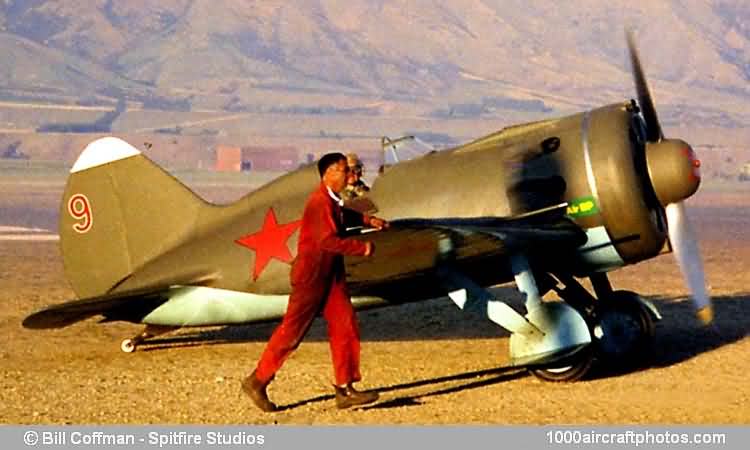A small pre-series designated I-16 Tip (Type) 1 was delivered from early 1935 with the M-22 engine, this being retained by the initial series model, the I-16 Tip 4, which differed externally in having a longer-chord cowling and of which about 400 were built. With availability of the 700 hp M-25 (license-built Cyclone) engine, production switched to the I-16 Tip 5 which introduced an entirely new tapered and shuttered engine cowling. Like the preceding series version, the Tip 5 carried two 0.30 in (7.62 mm) wing guns. It saw combat over Spain in November 1936.
From late 1936, the I-16 Tip 6 with a 730 hp M-25A engine was produced, this being succeeded in the following year by the Tip 10. Following 2,200 twin-gun I-16s (ie, Tip 4, 5 and 6), the Tip 10 added two fuselage-mounted 0.30 in (7.62 mm) guns and finally discarded the forward-sliding canopy of (but frequently removed from) earlier subtypes in favor of a fixed windscreen, and introduced landing flaps.
During 1938, the Spanish Hispano-Suiza began license production of the Tip 10, but with US manufactured R-1820-F54 Cyclone engines, 10 being delivered before the end of hostilities to supplement 278 (Tip 5, 6 and 10) delivered by the Soviet Union.
The I-16 Tip 12, built in small series, had the wing-mounted machine guns replaced with 0.787 in (20 mm) cannon, a similar armament being employed from early 1939 by the Tip 17 which used the 750 hp M-25V engine. ShVAK cannon availability limited Tip 17 production - only 734 (Tip 12 and 17) of the 6,555 single-seat I-16s manufactured to spring 1940 receiving cannon armament. A total of 142 Tip 10 and Tip 17 I-16s was supplied to China.
From the service debut of the I-16 to the phase-in of the Tip 17 version of the fighter early in 1939, normal loaded weight had risen by 41.7% and take off power by only 5.5%, the effect on virtually every aspect of performance being adverse. Therefore, as a fall-back in case development of its intended successor, the I-180, should prove unsuccessful, adaptation began in 1938 of the I-16 for the two-stage supercharged M-62 and direct-geared M-63 engines.
The 800 hp Shvetsov M-62 was adopted for the first stage of what might be referred to as the "second generation" I-16, this being introduced on the assembly lines in the spring of 1939 in the Tip 18 version. Essentially an interim model, the I-16 Tip 18 was, apart from engine and some local structural strengthening, fundamentally similar to the Tip 10, armament being four 0.30 in (7.62 mm) guns.
What was seen as the definitive development, the Tip 24, introduced a stiffened wing and a ShvetsovM-63 engine rated at 930 hp. Like the Tip18, the Tip 24 had provision for two flush-fitting 26.4 gal (100 l) wing tanks, armament comprising four 0.30 in (7.62 mm) guns, while the otherwise-similar Tip 27 combined the fuselage-mounted 0.30 in (7.62 mm) weapons with two wing-mounted 0.787 in (20 mm) cannon, and the Tip 29 could supple-ment a fuselage-mounted armament of one 0.50 in (12.7 mm) and two 0.30 in (7.62 mm) guns with four or six 3.23 in (82 mm) RS-82 rockets which could be carried in addition to the auxiliary tanks, overload weight rising to 4,663 lb (2,115 kg) .
Phased out in the spring of 1940, production of the I-16 was resumed a year later, a further 450 being built (mostly Tip 27 and Tip 29) to bring the total of single-seat models built to 7,005 (a further 1,639 having been built as Tip 4 UTI-2 and Tip 15 UTI-4 two-seat trainers). The I-16 formed marginally more than 65% of the entire Soviet fighter inventory at the time of the German assault.
The diminutive I-16 fighter had various popular names, Soviet pilots named it "Ishak" ("Donkey"), Spanish Nationalists used "Rata" ("Rat"), Spanish Republicans used "Mosca" ("Fly"), while Finnish pilots named it "Siipiorava" ("Flying Squirrel").
Despite the large numbers produced, very few have survived, primarily as museum static displays. Sir Tim Wallis and his Alpine Fighter Collection team of New Zealand had a key role in the restoration of six wrecks to airworthy condition by the original manufacturing plants at Novisibirsk, Russia, under guidance of Chief project manager Vladimir Berns (Senior Engineer at the Siberian Aeronautical Research Institute). After three years of slow progress the first aircraft was test flown in September 1995, with the remainder following by 1997. After testing all six aircraft were exported to New Zealand, however, they are no longer registered in New Zealand:
C/n 2421319. Former 155 Fighter Squadron, lost near Lake Kokkayaro in Karelia, located 1991. First restored aircraft, flown 1995, registered ZK-JIN, October 9, 1997, coded "9". Presently registered in Germany as D-EPRN.
C/n 2421234. Presumed of 197 Squadron, lost near Orzega 1941, recovered 1988. Registered ZK-JIO, October 9, 1997, coded "34". Registration cancelled July 23, 2009, exported to Russia, where it was registered RA-1561G.
C/n 2421645. Presumed of Leningrad Front Fighter Squadron, lost near Osinovets (near Leningrad), located 1991. Registered ZK-JIP, October 9, 1997, coded "45". Reregistered to American Airpower Heritage Museum, Midlands, Texas, USA as N30425, March 26, 2002.
C/n 2421014. Lost near Lake Yaglyayrvi in Karelia, located 1991. Registered ZK-JIQ on October 9th, 1997, coded "4". Registration cancelled November 25, 1998, became N7459, registered to Vulcan Warbirds Inc., Seattle, Washington, USA.
C/n 2421028. Former 155 Fighter Squadron, lost near Nigizero in Karelia, 1941-1942, located 1991. Registered ZK-JIR, October 9, 1997, coded "28". Reregistered to Training Services, Virginia Beach, Virginia, USA as N1639P on February 20, 2003.
C/n 2421039. Registered ZK-JJC, March 25, 1998, coded "39". Presently registered in Spain as EC-JRK, coded "CM-249"."
